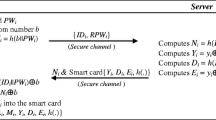Abstract
Most of the existing authentication and key agreement protocols for delay tolerant networks are not designed for protecting privacy. In this paper, an authentication and key agreement protocol with anonymity based on combined public key is proposed. The proposed protocol eliminates the need of public key digital certificate on-line retrieval, so that any on-line trusted third party is no longer required, only needs an off-line public information repository and key generation center; and realizes mutual authentication and key agreement with anonymity between two entities. We show that the proposed protocol is secure for all probabilistic polynomial-time attackers, and achieves good security properties, including authentication, anonymity, and confidentiality and so on.
Similar content being viewed by others
References
Cerf, V. et al. (2007). Delay-tolerant networking architecture. IETF RFC 4838.
Kate, A., Zaverucha, G. M, & Hengartner, U. (2007). Anonymity and security in delay tolerant networks. In Third international conference on security and privacy in communications networks and the workshops, secure Comm (2007) (pp. 504–513).
Su R., Cao Z.: An efficient anonymous authentication mechanism for delay tolerant network. Computers & Electrrial Engineering 36(3), 435–441 (2010)
Zhu H., Lin X., Liu R., Fan Y, Shen X.: SMART: A secure multilayer credit-based incentive scheme for delay-tolerant networks. IEEE Transactions on Vehicular Technology 58(8), 4628–4639 (2009)
Farrell, S., & Cahill, V. (2006). Security considerations in space and delay tolerant networks. In Second IEEE international conference on space mission challenges for information technology, SMC-IT 2006 (pp. 17–20).
Li, F., Srinivasan, A., & Wu, J. (2009). Thwarting blackhole attacks in disruption-tolerant networks using encounter tickets. In Proceedings of the 27th annual joint conference of IEEE communication and computer society (INFOCOM) (pp. 2428–2436).
Seth, A., & Keshav, S., (2005). Practical security for disconnected nodes. In 1st IEEE ICNP workshop on secure network protocols (pp. 31–36).
Challal Y., Ouadjaout A., Lasla N., Bagaa M., Hadjidj A.: Secure and efficient disjoint multipath construction for fault tolerant routing in wireless sensor networks. Journal of Network and Computer Applications 34(4), 1380–1397 (2011)
Tang, W., Nan, X., & Chen, Z. (2003). Elliptic curve cryptography-based combined public key technique. Computer Engineering and Applications, 21, 1–3.
Zhang R., Liu J. Q., Han Z., Zheng L. J.: An IBC scheme using ECC combined public key. Computers and Electrical Engineering 36(2010), 1046–1054 (2010)
Nan X. H.: Identity authentication based on combined public key. National Defense Industry Press, Beijing (2006)
Hou, H., & Liu, S. (2009). CPK-based authentication and key agreement protocols with anonymity for wireless network. In International conference on multimedia information networking and security (pp. 347–350).
Li W. et al.: A novel universal authentication protocol based on combined public key in heterogeneous networks. The Journal of China Universities of Posts and Telecommunications 17(Suppl), 1–5 (2010)
Li, J., Tan, L., & Long, D. (2008). A new key management and authentication method for WSN based on CPK. In ISECS international colloquium on computing, communication, control, and management (pp. 265–269).
Kata J., Lindell Y.: Introduction to modern cryptography. CRC Press, New York (2007)
Simon, B. W., & Menezes, A. (1999). Authenticated Diffie-Hellman key agreement protocols. Selected areas in cryptography. In Proceedings of the 5th annual international workshop, SAC’98 (pp. 339–361).
He D., Chen J., Hu J.: An ID-based client authentication with key agreement protocol for mobile client-server environment on ECC with provable security. Information Fusion 13(2012), 223–230 (2012)
Yang J. H, Chang C. C: An ID-based remote mutual authentication with key agreement scheme for mobile devices on elliptic curve cryptosystem. Computers & Security 28(2009), 138–143 (2009)
Author information
Authors and Affiliations
Corresponding author
Rights and permissions
About this article
Cite this article
Ding, Y., Zhou, Xw., Cheng, Zm. et al. Efficient Authentication and Key Agreement Protocol with Anonymity for Delay Tolerant Networks. Wireless Pers Commun 70, 1473–1485 (2013). https://doi.org/10.1007/s11277-012-0760-x
Published:
Issue Date:
DOI: https://doi.org/10.1007/s11277-012-0760-x




